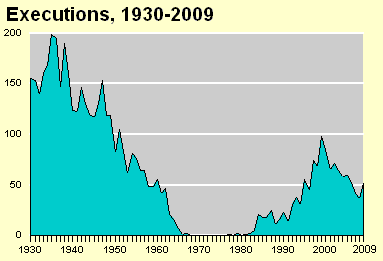12 electrocutions
7 gas chambers
4 hanging
1 firing squad
14 more than one method
Issues:
JAILS-differences
in staff, inmates and facilities compared to prisons
WARDEN-Superintendent:
Critical to conditions and general climate
of prison
Management styles of past wardens-
triggered growth of unionization among
employees
Power conflicts between employees and Management
Changes affecting management-
use of women administrators and staff members
Questions about the use of females in all male institutions
DIFFICULT TO RELATE VARIOUS FACTORS TO QUALITATIVE
PRISON ENVIRONMENT
What makes a difference?
THREE YEAR STUDY OF PRISON MANAGEMENT-
Texas, Michigan, California -looked
at:
No variations of above with:
ONLY DECIDING FACTOR:
"Quality of Prison Management "
Prison Management Matters
Important:
MAJOR RIOTS: result of breakdown in security procedures
(numbering, counting, frisking, locking, controlling contraband,
searching cells. Crowding, underfunding, poor inmate/staff relations
and racial conflict-riots more likely
Poor security management-riots inevitable
SIX GENERAL PRINCIPLES OF GOOD PRISON LEADERS
OLD PENOLOGISTS:
prison administrators-admirable public servants
NEW PENOLOGISTS:
administrators are loathsome and evil, inmates are responsible victims,
complete self government ideal.
Dilulio-need for NEW OLD PENOLOGY
Shift in attention from inmates to keepers
Tight administrative control more conducive to decent prison conditions
CONTEMPORARY CHALLENGES TO PRISON ADMINISTRATORS:
1. Where to place facilities
2. design and construction-costs and construction time
3. controlling health care costs
4. handling overcrowding
5. Developing alternatives to incarceration
6. dealing with gang issue
GANGS OR
us
PRISON
GANGS
7. AIDS
AIDS
IN PRISON PROJECT
HIV/AIDS
IN PRISON
8. Staff safety/training
9. Satisfying old court orders and consent decrees.
10. Enhancing security and programs with fewer resources
Rising costs in general
11. Inmate and staff litigation
Today more time spent in public policymaking arena-especially due to
tough on crime stance Willie Horton legacy-Tough on crime stance
politically attractive. Negative public image of corrections
Executions: 38 States and the federal government have a death penalty
27 states have lethal injections
12 electrocutions
7 gas chambers
4 hanging
1 firing squad
14 more than one method
![]()


(Source: http://bjs.ojp.usdoj.gov/index.cfm?ty=tp&tid=18)
EXECUTION TEAM:
Training important
Superintendent or representative present during execution
QUESTION: How are the members
of the execution team selected?
STAFF INMATE RELATIONSHIPS:
Inmates have power;
"Without consent and cooperation of inmates, prison could
not function"
EXPERIENCED CHANGE FROM correctional facility with programs
and activities to rehabilitate to:
Racially segregated, gang controlled warehouse
for convicts.
Combat zone
Balance of power between inmates and staff
Institution dependent on inmate labor to operate
Use of trustees
Privileges offered viewed as permanent-resistance if withdrawn
Lack of consistency in treatment of certain inmates-loss of credibility
Unclear what to expect
Cycle of increased demands by inmates, offering of incentives by staff,
and resulting imbalance results in Tensions which can escalate to major
disturbance
GOAL OF ADMINISTRATOR:
Create/maintain institutional culture that creates a balance between
power of staff and inmates
MANAGING CHANGE IN DELIBERATE MANNER:
Recommendation: periodic moving of inmates
to scheduled lock
down- contraband control and power assertion
Overcrowding:
Response: creation
of stable private space
creation of functional housing units-mini prisons
inmate surveys